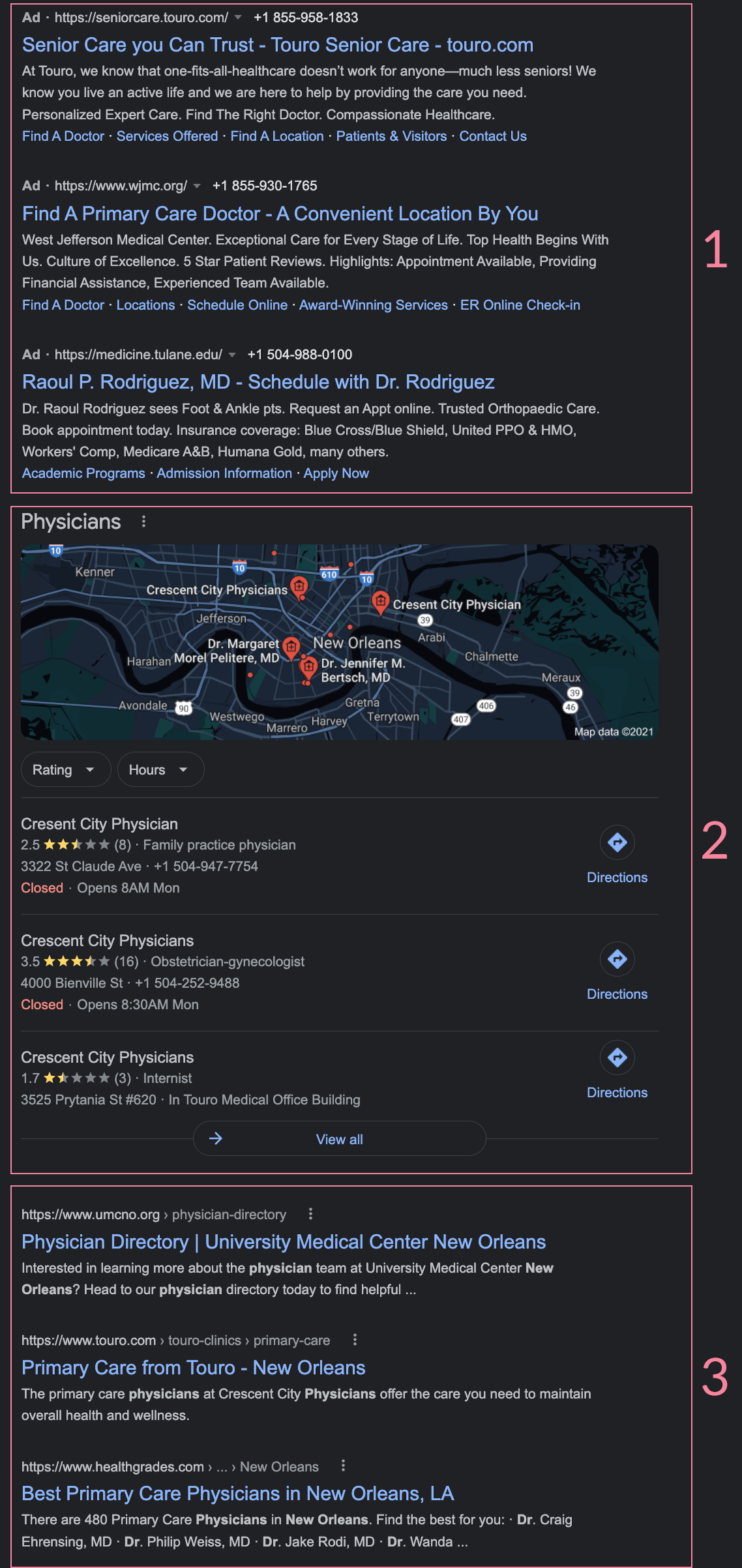At some point in running a private practice, you’ll start thinking about attracting more patients. One sure way to get more patients is to advertise yourself on the internet. Today, the opportunities for digital marketing are endless, yet there are a few channels and tools that dominate the market. The number one tool for marketing your private practice online is Google Ads.
In this article, we explain what Google Ads is, how it works, why it’s a must-have tool for physicians, and what mistakes to avoid when starting your digital ad campaign. Let’s dive in!
What is Google Ads?
Google Ads is an online advertising tool. Using this platform, it’s possible to create online ads that reach prospects precisely when they’re looking for services you provide.

This is how the Google search results page looks if you break it into three sections:
- The first section belongs to Google Ads, where you see the ads of businesses that paid to be displayed at the top of search results.
- In the second section is a map where Google My Business listings show up.
- Finally, in the third section, you see organic search results that are influenced by search engine optimization.
Google Ads is a bidding platform where businesses or individuals create ads and run them for specific keywords. Google’s algorithms decide which ads perform the best, which lead to relevant pages, and which are best to promote. Thus, even if you pay, there’s no guarantee your ads will be seen by users since you still need to consider numerous factors that we’ll cover below.
Why do you need to market your medical practice with Google Ads?
Nowadays, people actively search for doctors online, and most likely they’ll look on Google. Having an ad in Google search results is a big advantage for a business, as it means there’s a good chance of getting noticed when prospects need you. Below are the benefits of Google Ads for your medical practice:
- Any budget will do. There’s no minimum deposit, and you can get started even on a fairly low budget.
- Pay-per-click approach. You only pay when a prospect clicks on your ad.
- Advanced targeting features. Thanks to precise geotargeting, you can market your practice only to the area you’re interested in.
- Keyword research. The Keyword Planner allows you to tailor your message with relevant keywords, fight competitors, and increase the chances of your ad being seen by your prospects.
- Metrics to optimize your ads. Google Ads tools offer various metrics to track your performance, test hypotheses, and refine your results.
To sum up, Google Ads gives therapists a lot of control: full control over your budget, the ability to target specific ads to specific areas and audiences, and the ability to diagnose problem areas in your marketing campaign with the help of metrics.
Before you rush to your Google Ads account, however, you should learn the top mistakes to avoid while creating Google Ads campaigns for your private practice.
Top mistakes to avoid with Google Ads
1. Using the Google Ad Express version
If you’re not a marketer, starting with the Express version of Google Ads may sound like a good idea, since you won’t be overwhelmed with all the features, toggles, and buttons of the full version. Express does have some advantages for newcomers: you’ll quickly get acquainted and get started with the platform, pay only for results, and create ads faster. However, the Express version is quite limited, which means your results will be limited as well. In general, you will get few results for a little money, and it’s not going to get you very far in your marketing efforts.
We highly recommend switching to the full version of Google Ads to get powerful results. If you feel that you lack knowledge and skills, try contracting a marketer who will set up your campaigns for you. Otherwise, you’re going to be one physician competing against professional digital marketers.
2. Linking your ads to your home page
The most common mistake many physicians make is linking their ads to their website’s home page. While home pages are vital and useful, they are not helpful to clients looking for particular answers to problems. When people click on an ad, they’re seeking answers, and they’re more likely to leave your home page than to try to find the information they’re looking for within your site.
Create a specific ad and link it to a specific page on your website.

If your prospect searches for EMDR therapy, they don’t want to see the home page of your private practice or anything that is not related to EMDR. Users don’t want to make a bunch of unnecessary clicks to get the information they need. Your prospects want to land on a relevant page, get answers to their questions, and see how exactly you can help them.
Pro tip: Always match your prospects’ expectations after reading the ad’s CTA with the actual content on the page you lead your prospects to.
Keep in mind that you’re paying Google for each click. If you send potential clients to a specialized page, you’ll get a higher return on investment (ROI). You also build client trust and confidence when your link delivers specialized material that meets their needs, which is a vital and sometimes overlooked benefit.
3. Having an unclear or uncompelling message
In order for Google Ads to work, you have to address all the points of conversion. Here is the most common and simplest patient journey with points of conversion for a Google Ads campaign:

- A prospective patient researches their diagnosis on the internet.
- In one of the articles, the prospect is served a Google Display ad from a physician.
- The prospect clicks the ad and lands on a website page.
- The prospect looks through the page, finds answers to their questions, and decides to set up an appointment with the physician.
- Finally, the prospect books an appointment online or makes a phone call and converts into a patient.
If your ads are working well, they’re guaranteed to bring prospects to your pages. Now it’s up to your pages to do the job and get prospects to your booking page or get them to call your phone. Finally, you or your assistant needs to be able to convert a prospect into a patient. Every stage of this journey comes down to having strong, clear, and compelling copy. Your copy should focus on the benefits and outcomes of what you do for your patients.
4. Having an unclear call to action
A call to action, or CTA, is an invitation to take a specific action. It’s placed on a button that sends people to the next step — visit a website, fill out a contact form, make a call, book an appointment, etc. It’s important to have strong CTA copy and be clear with what action your prospects need to take or what they’ll get.

For example, your CTA might be a button saying “Book a session now,” “Send me prices,” “Download a health checklist,” or “Join a webinar.” Never leave the standard “Click here” or “Learn more” text — it’s not informative and doesn’t motivate a user to take action.
5. Expecting results too soon
It doesn’t matter whether you’re a professional marketer or a newcomer to Google Ads, there still is a testing period to check how your ads work in the market, get information, and make new hypotheses based on that information. There is a risk of getting frustrated with such an approach and seeing no results. You might even conclude that Google Ads don’t work at all. But you need to continue pushing forward with your ideas and testing new ads.
6. Ignoring performance tracking
Another reason why your Google Ads strategy might not work is that you don’t track your marketing performance and don’t know your numbers. If you don’t know your business’s key performance indicators (KPIs), you don’t know whether your marketing is going wrong. Consequently, you can’t make data-driven decisions and tailor your marketing efforts.
To effectively monitor, analyze, and optimize your marketing performance, consider tracking the following metrics:

7. Failing to convert prospects into clients
The last step is to communicate with your prospects on the phone, help them book an appointment, and convert them into your patients. Imagine you’ve set up ads, your CTAs are catchy and make prospects click them, your landing page is flawless, and your copy is clear and to the point. Every gear in the mechanism is working well and converting prospects except for the last one. If you or your assistant are nervous on the phone, don’t know how to talk to patients, don’t know your fees, or even don’t answer the phone at all, your marketing efforts go down the drain.
Talking on the phone with your prospect is the final conversion point, and only you are responsible for its success. Consider preparing scripts with the most frequent answers and responses to objections to be ready to address any prospect on the phone and convert them successfully.
Summing up
Running Google Ads is not a silver bullet to marketing your business, but it’s a must for increasing your brand awareness and getting more leads. However, just as with other digital marketing strategies, you must be careful to avoid making costly mistakes. In doing so, you can improve your chances of achieving success and, at the same time, avoid wasting your budget.
For more insights on how marketing for physicians works, subscribe to our newsletter below.




